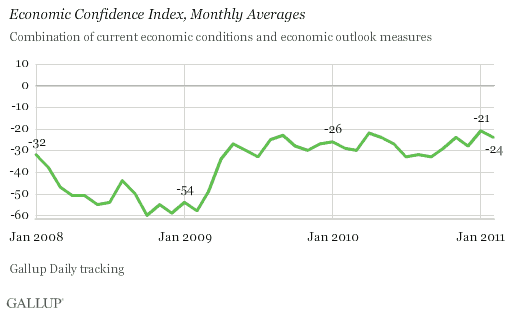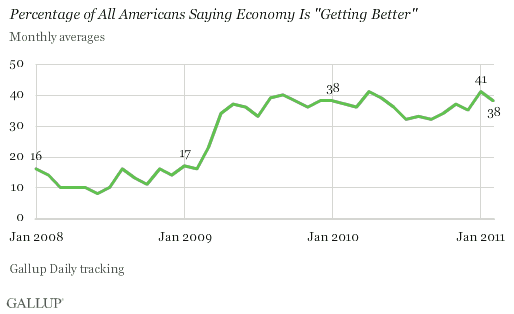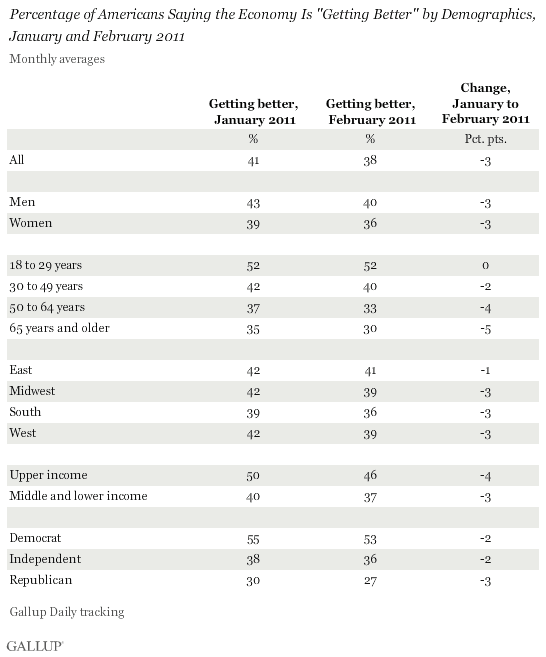PRINCETON, NJ -- Gallup's Economic Confidence Index worsened to -24 in February from -21 the prior month as Americans' optimism about the U.S. economy receded from a three-year high reached in January.

Gallup's Economic Confidence Index is based on two questions. One measures consumers' perceptions of current economic conditions and shows them to be the same in February as in January, with 42% of Americans rating current economic conditions "poor."
The second Index component asks Americans to rate the outlook for the U.S. economy. In February, 38% said economic conditions are "getting better," down from 41% a month earlier. However, this decline follows a January optimism level that tied for the highest since Gallup Daily tracking began in January 2008.

Optimism Declines Across Demographic Groups
More than half of Americans aged 18 to 29 and of Democrats say economic conditions are getting better. This makes them the most optimistic among key demographic groups. At the other end of the spectrum are Republicans, with 27% saying things are getting better, and older Americans, with 33% of those 55 to 64 and 30% of those 65 or older saying this.
The largest drops in optimism in February were among those 65 or older (down five points) and among upper-income Americans and those aged 50 to 64 (down four points each). Only younger Americans saw no drop in optimism between January and February.

Monthly Results Understate the Decline in Confidence
Gallup's weekly economic confidence data show that consumer optimism hit a new weekly high in mid-February but fell sharply during the second two weeks of the month. As a result, the decline in optimism reported for the month is an average bolstered by relatively high confidence early in February.
Recent events are not encouraging as far as the economy is concerned. Soaring gas prices, budget battles in Washington, D.C., as well as in many states, and recent declines on Wall Street suggest that Gallup's most recent weekly measure of -29 for the week ending March 6 may more accurately reflect current consumer confidence than February's monthly average.
Gallup.com reports results from these indexes in daily, weekly, and monthly averages and in Gallup.com stories. Complete trend data are always available to view and export in the following charts:
Daily: Employment, Economic Confidence and Job Creation, Consumer Spending
Weekly: Employment, Economic Confidence, Job Creation, Consumer Spending
Read more about Gallup's economic measures.
View our economic release schedule.
Survey Methods
Results are based on telephone interviews conducted with 13,349 respondents as part of Gallup Daily tracking during the month of February 2011, aged 18 and older, living in all 50 U.S. states and the District of Columbia, selected using random-digit-dial sampling.
For results based on the total weekly sample of national adults, one can say with 95% confidence that the maximum margin of sampling error is ±2 percentage points. For results based on the total monthly sample of national adults, one can say with 95% confidence that the maximum margin of sampling error is ±1 percentage point.
Interviews are conducted with respondents on landline telephones and cellular phones, with interviews conducted in Spanish for respondents who are primarily Spanish-speaking. Each daily sample includes a minimum quota of 200 cell phone respondents and 800 landline respondents, with additional minimum quotas among landline respondents for gender within region. Landline respondents are chosen at random within each household on the basis of which member had the most recent birthday.
Samples are weighted by gender, age, race, Hispanic ethnicity, education, region, adults in the household, cell phone-only status, cell phone-mostly status, and phone lines. Demographic weighting targets are based on the March 2010 Current Population Survey figures for the aged 18 and older non-institutionalized population living in U.S. telephone households. All reported margins of sampling error include the computed design effects for weighting and sample design.
In addition to sampling error, question wording and practical difficulties in conducting surveys can introduce error or bias into the findings of public opinion polls.
For more details on Gallup's polling methodology, visit www.gallup.com.
